Archive for September, 2009
September 30, 2009 @ 8:53 pm | Filed under:
Books Why, I wonder, am I so compelled to write about my reading life? I suppose it has something to do with memory, with holding on to things (we recall best those things which we have narrated, as Charlotte Mason was astute enough to recognize), and also with the way putting thoughts into words, written words, shifts vague and swirling impressions to coherent observations, connections, understanding.
Then, too, the urge to talk (write) about books springs also from booklover’s enthusiasm: when I’ve enjoyed something, or even just parts of something, I am eager, eager, eager to share. This creates all sorts of readerly, writerly dilemmas for me: sometimes I start conversations that I can’t squeeze out time to finish (though, in my mind, they are never finished, never closed; and I’m always figuring I’ll have a chance to chime in at some point). Sometimes I want to talk about books that I mostly loved, but I had this one quibble with a plot point, or I thought the ending was weak, or the first-person narrative voice was an unfortunate choice, or—well, any critical observations at all, and if the author is a living person, I find myself completely paralyzed at the prospect of putting my criticism in print. (Which is why, of course, I’m not a book reviewer by trade.)
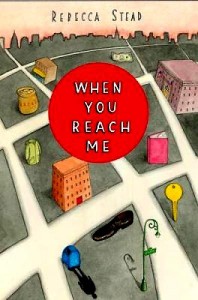 Then, of course, there’s the spoiler problem, over which I’ve sweated here before. For example, I want to tell you all about how much I enjoyed Rebecca Stead’s excellent middle-grade novel, When You Reach Me—but if I say anything, practically anything at all, I’ll give away things I’d rather you discovered yourself in the pages of the book, in the perfect way Stead has chosen to reveal them to you. I can say that it’s about a girl who reads A Wrinkle in Time repeatedly, constantly; that her best friend, a boy, abruptly withdraws from her; that her mother is a single, working mom hoping for a chance to shine on $20,000 Pyramid; that it’s 1979; that there’s a mystery; that there are characters I will never forget, completely fresh, completely believable; that I haven’t read a novel that nails the flavor of New York City so perfectly since, gosh, Harriet the Spy. But none of that tells you what I loved most about the book, or what makes it sing, or why I won’t soon forget it. I can’t tell you those things until you’ve read it—and then you won’t need me to, because you’ll know too.
Then, of course, there’s the spoiler problem, over which I’ve sweated here before. For example, I want to tell you all about how much I enjoyed Rebecca Stead’s excellent middle-grade novel, When You Reach Me—but if I say anything, practically anything at all, I’ll give away things I’d rather you discovered yourself in the pages of the book, in the perfect way Stead has chosen to reveal them to you. I can say that it’s about a girl who reads A Wrinkle in Time repeatedly, constantly; that her best friend, a boy, abruptly withdraws from her; that her mother is a single, working mom hoping for a chance to shine on $20,000 Pyramid; that it’s 1979; that there’s a mystery; that there are characters I will never forget, completely fresh, completely believable; that I haven’t read a novel that nails the flavor of New York City so perfectly since, gosh, Harriet the Spy. But none of that tells you what I loved most about the book, or what makes it sing, or why I won’t soon forget it. I can’t tell you those things until you’ve read it—and then you won’t need me to, because you’ll know too.
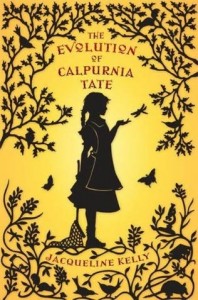 Or how about The Evolution of Calpurnia Tate by Jacqueline Kelly? I loved it: this funny, tangy tale of an eleven-year-old girl, surrounded by brothers on a Texas pecan farm in 1899, with a mother yearning for a girly-girl, a fascination with the critters whose doings she records in her very important notebook, and an aloof, bewhiskered grandfather who has never, until now, seemed to notice her existence. I was delighted by the way Callie and her grandfather become acquainted with one another via their mutual interest in the natural world—he’s a correspondent of Charles Darwin and an amateur naturalist and scientist, ever on the lookout for a new species of flora or fauna that might add his name to the rolls of the distinguished discoverers of the day. At first he reacts to Callie rather as if she’s a curious new species herself, and the feeling is mutual. Slowly, they bond…oh, I loved it, the slow revelation of kindred spirits. And meanwhile, there are family antics, and wondrous new technology coming to town (a telephone! an automobile!), and Callie has to figure out how to carve out time for her burning interests when the womenfolk in her life demand piano practice and embroidery and cookery lessons. Certainly there have been many books tackling a girl’s struggles to define and defend her own identity as the people around her seem determined to squeeze her into a mold she isn’t sure fits—I’ve worked with that theme myself, in my Martha books—but I don’t think we’ve ever seen anyone quite like Miss Calpurnia Tate. It’s the setting, the context, that sold me on this book: I’d place it with The Great Brain and Ginger Pye on my mental bookshelf: episodic, comical, historically delicious novels full of eccentric and lovable characters, with that something extra that sets them apart from the crowd.
Or how about The Evolution of Calpurnia Tate by Jacqueline Kelly? I loved it: this funny, tangy tale of an eleven-year-old girl, surrounded by brothers on a Texas pecan farm in 1899, with a mother yearning for a girly-girl, a fascination with the critters whose doings she records in her very important notebook, and an aloof, bewhiskered grandfather who has never, until now, seemed to notice her existence. I was delighted by the way Callie and her grandfather become acquainted with one another via their mutual interest in the natural world—he’s a correspondent of Charles Darwin and an amateur naturalist and scientist, ever on the lookout for a new species of flora or fauna that might add his name to the rolls of the distinguished discoverers of the day. At first he reacts to Callie rather as if she’s a curious new species herself, and the feeling is mutual. Slowly, they bond…oh, I loved it, the slow revelation of kindred spirits. And meanwhile, there are family antics, and wondrous new technology coming to town (a telephone! an automobile!), and Callie has to figure out how to carve out time for her burning interests when the womenfolk in her life demand piano practice and embroidery and cookery lessons. Certainly there have been many books tackling a girl’s struggles to define and defend her own identity as the people around her seem determined to squeeze her into a mold she isn’t sure fits—I’ve worked with that theme myself, in my Martha books—but I don’t think we’ve ever seen anyone quite like Miss Calpurnia Tate. It’s the setting, the context, that sold me on this book: I’d place it with The Great Brain and Ginger Pye on my mental bookshelf: episodic, comical, historically delicious novels full of eccentric and lovable characters, with that something extra that sets them apart from the crowd.
And I’ve ten times written and deleted a sentence of criticism about one of these two novels, which my what-if-I-hurt-the-writer’s-feelings cowardice will not allow me to keep intact. How’s that for some obnoxious ambiguity?
September 30, 2009 @ 7:20 pm | Filed under:
Links The September Carnival of Children’s Literature is up at Susan Writes: another excellent assortment of posts from the prolific kidlitosphere.
September 29, 2009 @ 7:55 pm | Filed under:
Books  The Beany Malone books by Lenora Mattingly Weber have been recommended to me many a time over the years, usually by fellow Betsy-Tacy and Anne Shirley fans. I finally got around to reading the first in the series, Meet the Malones, and I found it enjoyable and—peculiar.
The Beany Malone books by Lenora Mattingly Weber have been recommended to me many a time over the years, usually by fellow Betsy-Tacy and Anne Shirley fans. I finally got around to reading the first in the series, Meet the Malones, and I found it enjoyable and—peculiar.
The heroine of Meet the Malones is fifteen-year-old Mary Fred Malone, older sister of Beany (christened Catherine Cecilia) who takes center stage in subsequent books. Mary Fred is a cheerful, impulsive, idealistic girl whose siblings consider her the family rock, the person whose core of strength helps others stand firm. It’s 1942 and, oh yes, there’s a war on. Mary Fred’s father is a respected newspaperman, writer of stirring editorials that challenge the citizens of Denver to dig deep, give of their time and treasure, and open their homes to soldiers, orphans, the elderly, the lonely, the friendless. Snooty Mrs. Socially-prominent Adams next door may look down on the eccentric Malones, but their warmth and generosity has earned them the affection and respect of most everyone else who knows them.
Besides Beany and Mary Fred, there is brother Johnny of the winning smile and writerly genius, and oldest sister Elizabeth, a young war bride whose arrival home is but one of the many lively events of the opening chapters. When we meet Mary Fred, she has just bought an injured horse, rashly spending the money her step-grandmother sent her for a gown for the spring formal. Leading the horse home in a blizzard, wondering how she’ll come up with the remaining fifteen dollars she owes the stable-owner, she witnesses a fender bender between her brother Johnny and a car full of eggs—dozens of eggs. The eggs belong to a farm wife from Wyoming who has been saving them, all 48 dozen of them (!), to sell here in Denver where they’ll fetch a better price. Johnny’s dream of replacing his battered old typewriter shatters like an eggshell as he tallies up how much it’ll cost to pay for the ruined eggs and the repairs to the egg lady’s car—which, as it happens, is driven by a tall and handsome (but not too handsome) young cowboy named Anders—who, as it further happens, is coming to live with his aunt, Mrs. Socially-prominent Adams while taking a premed course at the university.
This breathless pace continues throughout the book, with event after event piling on—we have spunky war refugees, and an elderly history buff with a wandering mind, and an overbearing step-grandmother, and more war orphans, and a completely unlikable big-man-on-campus whom Mary Fred inexplicably adores, and various debts, and a new baby, and a missing G.I.—and yet somehow the storytelling is always quite clear. Weber deftly weaves six or seven strands of storyline together, now this one on top, now another, tying them all together neatly (a little too neatly) at the end.
It isn’t brilliant writing, nor at all lyrical. And Weber pounds her moral home with a pretty big hammer. (All the various subplots reinforce the theme of “You don’t get something for nothing,” which is broadcast so frequently that it might as well be stitched on a sampler and hung on the wall.)
And yet—it was a delightful read. The 1940s dialogue and local color is quaint and charming, and the Malones are an entirely loveable bunch. Well, almost entirely. Mary Fred’s crush on the deplorable Dike Williams, school football hero and user of the first order, is dippy and irritating: it’s so clear to the reader that he’s a jerk, even granting allowances for the cringeworthy slang of 70 years ago. (“Hey, gal. Will you be my squaw at the party?”) Mary Fred’s blind crush on this swaggering narcissist drives a great deal of the plot, and before long you’re wanting someone to take her by the shoulders and give her a good shake.
I think I’ve read that Weber improves as the series progresses, so I’ll have to keep reading and see if the things I enjoyed about Mary Fred and kin continue to outnumber the things that made me wince.
September 29, 2009 @ 7:00 pm | Filed under:
Television A perk of living on the west coast is that by the time I get up on Monday morning, the East Coasters have written their morning-after-Mad-Men posts. I don’t know about you, but I love the dimension that internet recaps and essays have added to my television viewing. First I get to talk an episode over with Scott, and the next day I get to consider the insights of other ponderers. Beats a water cooler any day.
Here are my favorite of the Mad Men regulars:
• The Footnotes of Mad Men. Want to see the Volkswagen ad Don is heaping scorn on? Unclear on what’s the big deal about a Hermes scarf? This blog is what an American studies course looks like in the 21st century—or should.
• The weekly open thread hosted by Ta-Nehisi Coates at The Atlantic. Thoughtful, intelligent discussion in the comments.
• The TV Club at Slate: author Patrick RaddenKeefe and Slate editors Julia Turner and John Swansburg post letters to each other in which they take turns probing the night’s themes, twists, and tensions.
Got any Mad Men must-reads in your reader?
September 29, 2009 @ 1:01 pm | Filed under:
Books Betsy-Tacy Convert Week is underway!
I received my giveaway copy (destined for Laurie of Seaglass Hearts) and am rooting for Team Philomathian. The reissues are perfectly lovely, I must say. Wonderful feel to the covers (and that swoony vintage art), the classic Vera Neville illustrations, and loads of photos and extras in the back.
May I ask a favor? If you happened to hear about Betsy-Tacy for the first time here at Bonny Glen (I know a few folks have mentioned that this is the case), would you drop me a note in the comments?
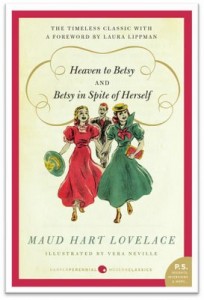
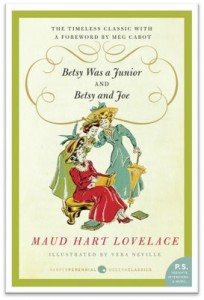

I recently located a copy of The Betsy-Tacy Companion: A Biography of Maud Hart Lovelace and have been looking forward to inhaling it just as soon as I emerge from my current reading jag (the YA novels of Laurie Halse Anderson). Liz’s new post at Tea Cozy has me all the more eager. It’s kind of thrilling for me to realize I’m living not too far from some bona fide Maud Hart Lovelace sites here in SoCal. I sense some field trips ahead…
Jane shares my relish for a good little-kid story and often emails me choice snippets of conversations she has overheard. This one made me laugh out loud for real (LOLFR?).
Rilla, AKA ‘mommy’: “I want a lollipop!”
Beanie: “No, you’re too sick to have a lollipop.”
Rilla: “But I WANT one!”
Beanie: “Oh, fine, here’s one.”
Then she pulled out an invisible lollipop.
And Rilla said: “No! I want a RED one!”
September 28, 2009 @ 7:21 am | Filed under:
Links
- San Diego Reader | There Is No San Diego River -“We’re setting out to see if this 52-mile-long ribbon of life still has life in it. Or if it has been dammed and developed and poisoned to death by us — the three million people who’ve come here to a semi-desert and expect water whenever we turn the taps on.”
- Bites of passage – The National Newspaper – ““There was no Jersey Shore before mosquito control,” Farajollahi, the county mosquito control superintendent, said – the coastal areas now filled with tourists originally belonged to clouds of hostile mosquitoes, which ranged far inland as well.”
The Betsy-Tacy reissues are out! And just in the nick of time: my old copies are about to fall apart from an abundance of love.
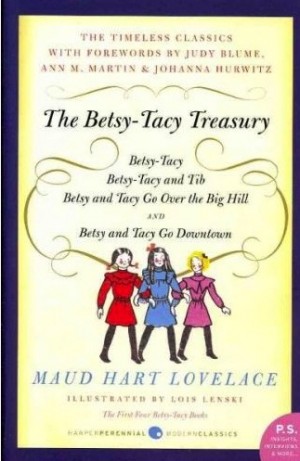



Over the next few weeks, a number of bloggers will be sharing their enthusiasm for the books of Maud Hart Lovelace in the Betsy-Tacy Book Blog Tour. Of course, my own enthusiasm has been spilling all over this blog for the past many weeks. I am tickled pink to see these books back in print. (I’ve been sitting here searching for the right adjective for “books” in that sentence: wonderful? delightful? important? fabulous? life-affecting? Everything sounds hackneyed or overused, but they’re all true.)
This week I reread my favorite of the “young” Betsy books.
(The series divides neatly into the young books—the first four titles, during which Betsy grows from age 5 to 12—and the older books, one for each year of high school, plus Betsy’s year abroad, and the year of her wedding. There are also a few related titles: Winona’s Pony Cart, another “young” book, and two older ones: Carney’s House Party and Emily of Deep Valley, which you know I adore.)
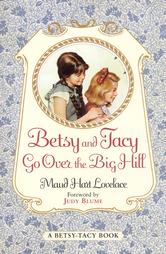 Betsy and Tacy Go Over the Big Hill, the third book in the series, is one of those books that stays with you a long time. Snippets and images from Big Hill pop into my head all the time, especially when I’m witnessing quarrels between my daughters—a great deal of the plot centers on a disagreement between Betsy-and-Tacy and their older sisters, Julia and Katie. Like so many of the childhood events that weigh heavily on small shoulders, this quarrel over who is to be the Queen of Summer—which begins lightheartedly but turns tense and ugly—is deeply distressing to ten-year-old Betsy, who is torn between angry frustration and a desire to put things right with her beloved and much-admired sister. Lovelace’s sensitivity and good humor are in full force as Betsy and the other girls struggle to find their way out of the mess.
Betsy and Tacy Go Over the Big Hill, the third book in the series, is one of those books that stays with you a long time. Snippets and images from Big Hill pop into my head all the time, especially when I’m witnessing quarrels between my daughters—a great deal of the plot centers on a disagreement between Betsy-and-Tacy and their older sisters, Julia and Katie. Like so many of the childhood events that weigh heavily on small shoulders, this quarrel over who is to be the Queen of Summer—which begins lightheartedly but turns tense and ugly—is deeply distressing to ten-year-old Betsy, who is torn between angry frustration and a desire to put things right with her beloved and much-admired sister. Lovelace’s sensitivity and good humor are in full force as Betsy and the other girls struggle to find their way out of the mess.
But in the book’s opening, there is no hint of a storm on the horizon.
Oh, Betsy’s ten tomorrow
and then all of us are ten!
We will all be ten tomorrow,
We will all be ladies then.
Who can forget the fun of that opening scene! Tib turned ten in January, and Tacy was ten in March, but with Betsy lagging behind—she’s an April birthday—the others are too polite to make a big deal about having reached such an advanced age. Now it’s the day before the long-awaited April date, and the three friends are ready to put childish things like parades behind them and commence being ladies, prinking their little fingers over tea and expanding their vocabulary to include mature words such as “prefer” and “indeed.” And with the sixteen-year-old King of Spain making a stir in all the papers, it is inevitable that such sophisticated persons as Betsy and Tacy will decide it’s high time they fell in love. It’s a bewildered Tib, they decide, who ought to marry him—after all, her new accordion-pleated dress is fit for a queen. Alas, she is not of “the blood royal,” and the girls feel compelled to pen a letter explaining to the young king why the marriage cannot take place. That’s what sophisticated ladies would do, you know.
In the first two books, we got to know Betsy, Tacy, and Tib in the cozy setting of their small-town neighborhood: their kitchens, their yards, their school, and the gentle, grassy slope of the Big Hill that rises beyond Betsy and Tacy’s houses. Now that they are such grown-up young ladies, the trio of ten-year-olds ventures beyond the crest of the hill all alone for the first time. The adventure that meets the girls on the other side is wholly unexpected and unexpectedly thought-provoking.
Here in Betsy’s beloved Deep Valley, Minnesota, we expect to meet folks like the kindhearted Scandinavian neighbor, Mrs. Ekstrom, Tacy’s bustling Catholic family, and Tib’s proud German mother. What we don’t, perhaps, expect to find in this turn-of-the-20th-century small Midwestern town is a thriving community of Lebanese immigrants—refugees from religious persecution, recently arrived in America and proudly working toward American citizenship.
The community called “Little Syria” in the Betsy-Tacy books is, like most of the events in this series, based on real people. Just over the hill from Mankato, Minnesota (Deep Valley in the books) was a village called Tinkcomville, named after its founder, James Tinkcom. Tinkcom bought the land in 1873, expecting to sell it in lots for development, but it turned out to be too far from town to appeal to most Mankato folks. Finally, in the 1890s, he sold the lots to a group of immigrants from Lebanon. In Big Hill, Tinkcom—that is, “Mr. Meecham”—is described as a reclusive and curmudgeonly sort, living in a big brick house near Little Syria and not mingling overmuch with the Deep Valley folks. However, there’s a place in his heart for anyone who befriends the good people of Little Syria—which is exactly what Betsy, Tacy, and Tib find themselves doing when their last pre-double-digits parade takes them over the crest of the Big Hill to a slope overlooking the village.
The girls’ shock at having walked so far alone dissipates quickly when they remember how grown-up they are now, on this eve of Betsy’s big day.
“Well, I’m surprised!” said Tacy. “I never knew we could walk to Little Syria.”
“I’m not surprised,” said Betsy.
“You’re not?” asked Tacy.
“No,” said Betsy. “Remember I’ll be ten tomorrow. It’s the sort of thing we’ll be doing often from now on.”
“Going to other towns?” asked Tacy.
“Yes. Little Syria, Minneapolis. Chicago. New York.”
“I’d love to go to New York and see the Flatiron Building,” said Tacy.
Tib looked puzzled.
“But Little Syria,” she said, “is just over our own hill. We didn’t know that it was. But it is.”
“Well, we certainly didn’t find it out until today,” said Betsy.
“We certainly never walked to it before,” said Tacy.
“That’s right,” admitted Tib.
This sunny confidence is what makes Betsy irresistible to the Deep Valley small fry—and to generations of readers. (In the high-school books, her confidence will waver a little, and she is sometimes prey to a kind of listless depression—but this, too, is part of Betsy’s appeal. She’s a real girl, imperfect, wrestling with moods and passions and uncertainties, trying to figure out who she is and who she wants to be, and sometimes puzzled by how vehemently her family and friends declare she’s just right just the way she is, imperfections and all.)
One day Betsy will roam the Great World, but right now, poised atop the Big Hill and at the brink of ten, the path before her is full of adventures she—yes, even she of the big imagination—could never have imagined. First there is the encounter with Naifi, one of the Syrians, “a little girl so strange she seemed to have stepped out of one of Betsy’s stories.” Strange, that is, to the eyes of a Deep Valley girl who has never seen a child with earrings and a “long skirt, like a woman’s,” speaking a language Betsy, Tacy, and Tib cannot understand. The language of picnics is universal, however, and over their different kinds of bread, a friendship is born. Before long the Deep Valley trio will find themselves springing into battle to defend their new chum, venturing into houses where the grandpas smoke hubble-bubble pipes and the grandmas pound lamb with mallets, and, eventually, learning from these new neighbors a deepened pride and appreciation for what it means to be an American.
And then, of course, there’s that sisterly quarrel still to patch up. Who will be the Queen of Summer? And whatever became of the letter Betsy, Tacy, and Tib sent to the King of Spain?
Would you believe I was supposed to write about two books in this post? I could easily go on yapping for several more pages about Big Hill. Could spend about a week mining the riches of Betsy and Tacy Go Downtown. But this post is already a ridiculous 1400 words long. So let me ask you: Which one do you like best—Big Hill or Go Downtown? (I mean: the Christmas shopping, the play, the delicious Mr. and Mrs. Poppy, the horseless carriage! The three telephone calls! Oh!)
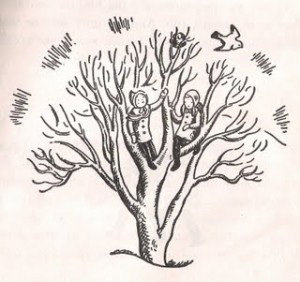 Several Betsy-Tacy fan club chapters around the country are hosting special events to celebrate the reissue of the books. If you’re in the vicinity of any of these—I’m jealous!
Several Betsy-Tacy fan club chapters around the country are hosting special events to celebrate the reissue of the books. If you’re in the vicinity of any of these—I’m jealous!
9/30 Aliso Viejo, CA, at the Aliso Viejo Library
10/3 Mankato, MN, at the Betsy Tacy Houses
10/3 Mesquite, TX, at Borders
10/23 Bainbridge Island, WA, at the Library (This date is tentative.)
11/7 Highland Village, TX, at Barnes and Noble
11/8 St. Paul, MN, at the Red Balloon Bookshop
4/17/10 Dallas, TX, at the Dallas Heritage Museum
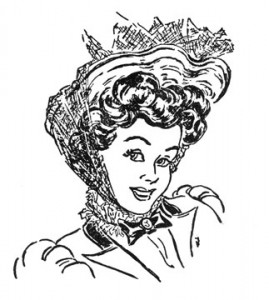
Related posts:
Heaven to Betsy! High-school-and-beyond books being reissued! (Sept 2009)
Betsy and Tacy Go Over the Big Hill
The Betsy-Tacy Songbook
Interview with Mitali Perkins, Jennifer Hart, and me about Maud’s books
Betsy-Tacy booksigning at ALA Midwinter
Photos of my visit to the real Deep Valley, as chronicled by Margaret in Minnesota
Why I love Carney
Why I love Emily
A Reader’s Guide to Betsy-Tacy
for more pictures…

the godmother gets
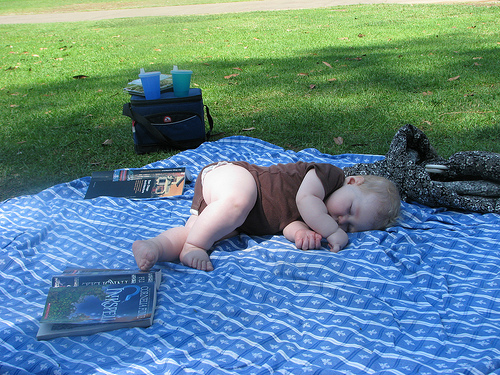
more pictures. 🙂
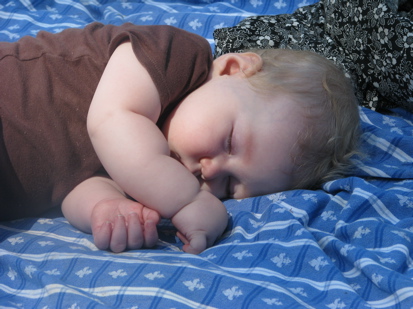
 Then, of course, there’s the spoiler problem, over which I’ve sweated here before. For example, I want to tell you all about how much I enjoyed Rebecca Stead’s excellent middle-grade novel, When You Reach Me—but if I say anything, practically anything at all, I’ll give away things I’d rather you discovered yourself in the pages of the book, in the perfect way Stead has chosen to reveal them to you. I can say that it’s about a girl who reads A Wrinkle in Time repeatedly, constantly; that her best friend, a boy, abruptly withdraws from her; that her mother is a single, working mom hoping for a chance to shine on $20,000 Pyramid; that it’s 1979; that there’s a mystery; that there are characters I will never forget, completely fresh, completely believable; that I haven’t read a novel that nails the flavor of New York City so perfectly since, gosh, Harriet the Spy. But none of that tells you what I loved most about the book, or what makes it sing, or why I won’t soon forget it. I can’t tell you those things until you’ve read it—and then you won’t need me to, because you’ll know too.
Then, of course, there’s the spoiler problem, over which I’ve sweated here before. For example, I want to tell you all about how much I enjoyed Rebecca Stead’s excellent middle-grade novel, When You Reach Me—but if I say anything, practically anything at all, I’ll give away things I’d rather you discovered yourself in the pages of the book, in the perfect way Stead has chosen to reveal them to you. I can say that it’s about a girl who reads A Wrinkle in Time repeatedly, constantly; that her best friend, a boy, abruptly withdraws from her; that her mother is a single, working mom hoping for a chance to shine on $20,000 Pyramid; that it’s 1979; that there’s a mystery; that there are characters I will never forget, completely fresh, completely believable; that I haven’t read a novel that nails the flavor of New York City so perfectly since, gosh, Harriet the Spy. But none of that tells you what I loved most about the book, or what makes it sing, or why I won’t soon forget it. I can’t tell you those things until you’ve read it—and then you won’t need me to, because you’ll know too. Or how about The Evolution of Calpurnia Tate by Jacqueline Kelly? I loved it: this funny, tangy tale of an eleven-year-old girl, surrounded by brothers on a Texas pecan farm in 1899, with a mother yearning for a girly-girl, a fascination with the critters whose doings she records in her very important notebook, and an aloof, bewhiskered grandfather who has never, until now, seemed to notice her existence. I was delighted by the way Callie and her grandfather become acquainted with one another via their mutual interest in the natural world—he’s a correspondent of Charles Darwin and an amateur naturalist and scientist, ever on the lookout for a new species of flora or fauna that might add his name to the rolls of the distinguished discoverers of the day. At first he reacts to Callie rather as if she’s a curious new species herself, and the feeling is mutual. Slowly, they bond…oh, I loved it, the slow revelation of kindred spirits. And meanwhile, there are family antics, and wondrous new technology coming to town (a telephone! an automobile!), and Callie has to figure out how to carve out time for her burning interests when the womenfolk in her life demand piano practice and embroidery and cookery lessons. Certainly there have been many books tackling a girl’s struggles to define and defend her own identity as the people around her seem determined to squeeze her into a mold she isn’t sure fits—I’ve worked with that theme myself, in my Martha books—but I don’t think we’ve ever seen anyone quite like Miss Calpurnia Tate. It’s the setting, the context, that sold me on this book: I’d place it with The Great Brain and Ginger Pye on my mental bookshelf: episodic, comical, historically delicious novels full of eccentric and lovable characters, with that something extra that sets them apart from the crowd.
Or how about The Evolution of Calpurnia Tate by Jacqueline Kelly? I loved it: this funny, tangy tale of an eleven-year-old girl, surrounded by brothers on a Texas pecan farm in 1899, with a mother yearning for a girly-girl, a fascination with the critters whose doings she records in her very important notebook, and an aloof, bewhiskered grandfather who has never, until now, seemed to notice her existence. I was delighted by the way Callie and her grandfather become acquainted with one another via their mutual interest in the natural world—he’s a correspondent of Charles Darwin and an amateur naturalist and scientist, ever on the lookout for a new species of flora or fauna that might add his name to the rolls of the distinguished discoverers of the day. At first he reacts to Callie rather as if she’s a curious new species herself, and the feeling is mutual. Slowly, they bond…oh, I loved it, the slow revelation of kindred spirits. And meanwhile, there are family antics, and wondrous new technology coming to town (a telephone! an automobile!), and Callie has to figure out how to carve out time for her burning interests when the womenfolk in her life demand piano practice and embroidery and cookery lessons. Certainly there have been many books tackling a girl’s struggles to define and defend her own identity as the people around her seem determined to squeeze her into a mold she isn’t sure fits—I’ve worked with that theme myself, in my Martha books—but I don’t think we’ve ever seen anyone quite like Miss Calpurnia Tate. It’s the setting, the context, that sold me on this book: I’d place it with The Great Brain and Ginger Pye on my mental bookshelf: episodic, comical, historically delicious novels full of eccentric and lovable characters, with that something extra that sets them apart from the crowd.
 The Beany Malone books by Lenora Mattingly Weber have been recommended to me many a time over the years, usually by fellow Betsy-Tacy and Anne Shirley fans. I finally got around to reading the first in the series, Meet the Malones, and I found it enjoyable and—peculiar.
The Beany Malone books by Lenora Mattingly Weber have been recommended to me many a time over the years, usually by fellow Betsy-Tacy and Anne Shirley fans. I finally got around to reading the first in the series, Meet the Malones, and I found it enjoyable and—peculiar.




 Several Betsy-Tacy fan club chapters around the country are hosting special events to celebrate the reissue of the books. If you’re in the vicinity of any of these—I’m jealous!
Several Betsy-Tacy fan club chapters around the country are hosting special events to celebrate the reissue of the books. If you’re in the vicinity of any of these—I’m jealous!


